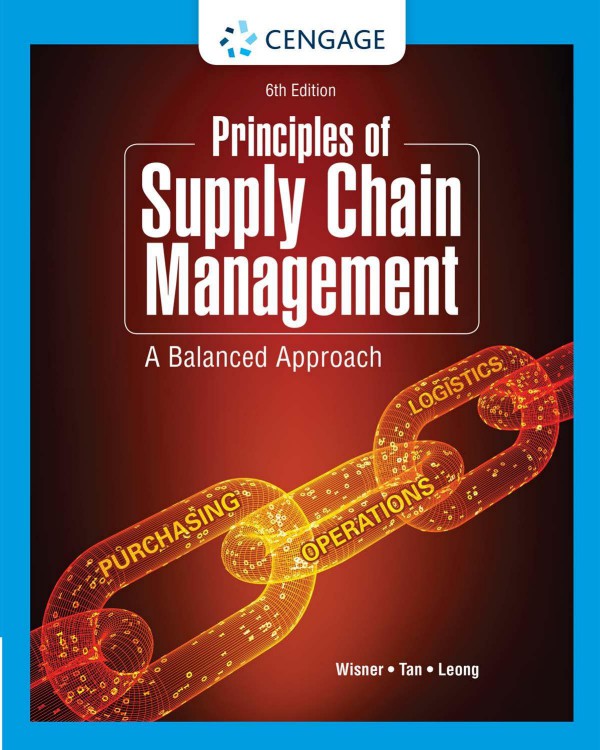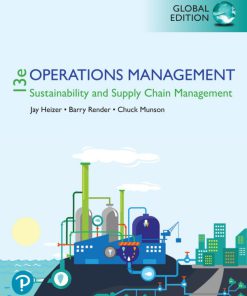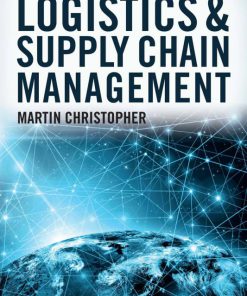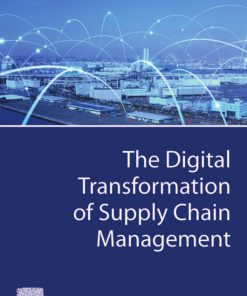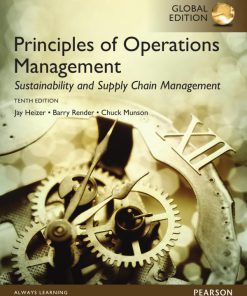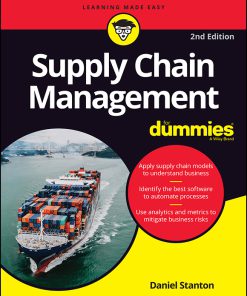Principles of Supply Chain Management 6th Edition by Joel Wisner, Keah Choon Tan, Leong ISBN 9780357715604 0357715608
$50.00 Original price was: $50.00.$25.00Current price is: $25.00.
Authors:Wisner, Joel D.;Tan, Keah-Choon;Leong, G. Keong; , Series:Management [781] , Author sort:Wisner, Joel D.;Tan, Keah-Choon;Leong, G. Keong; , Languages:Languages:eng , Published:Published:Jan 2022 , Publisher:Cengage Learning
Principles of Supply Chain Management 6th Edition by Joel Wisner, Keah Choon Tan, Leong – Ebook PDF Instant Download/Delivery. 9780357715604 ,0357715608
Full download Principles of Supply Chain Management 6th Edition after payment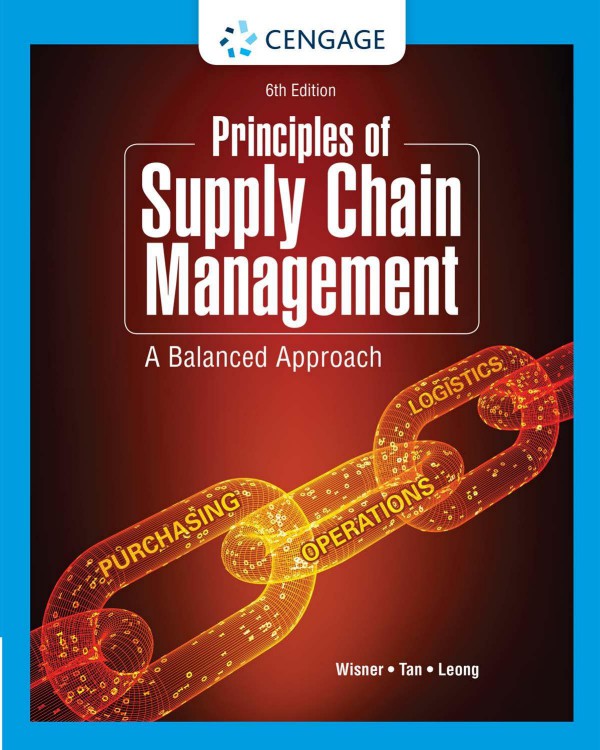
Product details:
ISBN 10: 0357715608
ISBN 13: 9780357715604
Author: Joel Wisner, Keah Choon Tan, Leong
Part 1. Supply Chain Management: An Overview
Chapter 1. Introduction to Supply Chain Management
Introduction
Supply Chain Management Defined
The Importance of Supply Chain Management
The Origins of Supply Chain Management in the United States
The Foundations of Supply Chain Management
Supply Elements
Operations Elements
Logistics Elements
Integration Elements
Current Trends in Supply Chain Management
Use of Supply Chain Analytics
Improving Supply Chain Sustainability
Increasing Supply Chain Visibility
Summary
Key Terms
Discussion Questions
Essay/Project Questions
Cases
Appendix 1.1. The Beer Game
Additional Resources
Endnotes
Part 2. Supply Issues in Supply Chain Management
Chapter 2. Purchasing Management
Introduction
A Brief History of Purchasing Terms
The Role of Supply Management in an Organization
The Financial Significance of Supply Management
The Purchasing Process
The Manual Purchasing System
Electronic Procurement Systems (E-Procurement)
Small-Value Purchase Orders
Sourcing Decisions: The Make-or-Buy Decision
Reasons for Buying or Outsourcing
Reasons for Making
Make-or-Buy Break-Even Analysis
Roles of the Supply Base
Supplier Selection
Supplier Diversity
The Total Cost of Ownership Concept
How Many Suppliers to Use
Reasons Favoring a Single Supplier
Reasons Favoring Multiple Suppliers
Purchasing Organization
Advantages of Centralization
Advantages of Decentralization
Global Sourcing
Reasons for Global Sourcing
Potential Challenges for Global Sourcing
International Trade Law and Commercial Terms
Procurement in Government and Nonprofit Agencies
Characteristics of Public Procurement
Summary
Key Terms
Discussion Questions
Essay/Project Questions
Spreadsheet Problems
Cases
Part 2 Continuing Case
Additional Resources
Chapter 3. Creating and Managing Supplier Relationships
Introduction
Developing Supplier Relationships
Building Trust
Shared Vision and Objectives
Personal Relationships
Mutual Benefits and Needs
Commitment and Top Management Support
Change Management
Information Sharing and Transparent Communications
Relationship Capabilities
Performance Metrics
Continuous Improvement
Monitoring Supplier Relationships
Key Takeaways
Managing Supplier Relationships during the Covid-19 Pandemic
Supplier Evaluation and Certification
The Weighted Criteria Evaluation System
External Certifications
Supplier Development
Supplier Recognition Programs
Supplier Relationship Management
Summary
Key Terms
Discussion Questions
Problems
Essay/Project Questions
Cases
Part 2 Continuing Case
Chapter 4. Ethical and Sustainable Sourcing
Introduction
Ethical and Sustainable Sourcing Defined
Ethical Sourcing
Sustainable Sourcing
Developing Ethical and Sustainable Sourcing Strategies
Ethical and Sustainable Sourcing Initiatives
Ethical and Sustainable Supplier Certification Programs
Supply Base Rationalization Programs
Outsourcing Products and Services
Early Supplier Involvement
Vendor Managed Inventories
Strategic Alliance Development
Negotiating Win–Win Strategic Alliance Agreements
Rewarding Supplier Performance
Benchmarking Successful Sourcing Practices
Assessing and Improving the Firm’s Sourcing Function
Summary
Key Terms
Discussion Questions
Essay/Project Questions
Cases
Part 2 Continuing Case
Additional Resources
Endnotes
Part 3. Operations Issues in Supply Chain Management
Chapter 5. Demand Forecasting
Introduction
The Importance of Demand Forecasting
Demand Forecasting Techniques
Qualitative Methods
Quantitative Methods
Cause-and-Effect Models
Multiple Regression Forecast
Forecast Performance
Using Lag in Measuring Forecast Error
Demand Sensing
Demand Planning During the COVID-19 Pandemic and Beyond
Useful Forecasting Websites
Forecasting Software
Artificial Intelligence and Machine Learning in Demand Forecasting
Cloud-Based Forecasting
Summary
Key Terms
Discussion Questions
Problems
Essay/Project Questions
Cases
Part 3 Continuing Case
Chapter 6. Resource Planning Systems
Introduction
Operations Planning
The Aggregate Production Plan
The Chase Production Strategy
The Level Production Strategy
The Mixed Production Strategy
The Master Production Schedule
Master Production Schedule Time Fence
Available-to-Promise Quantities
The Bill of Materials
The Material Requirements Plan
Terms Used in Material Requirements Planning
An Example of MRP Computation without Net Requirements and Planned Order Receipts
An Example of MRP Computation with Net Requirements and Planned Order Receipts
Capacity Planning
Capacity Strategies
The Distribution Requirements Plan
The Legacy Material Requirements Planning Systems
Manufacturing Resource Planning
The Development of Enterprise Resource Planning Systems
The Rapid Growth of Enterprise Resource Planning Systems
Implementing Enterprise Resource Planning Systems
Advantages and Disadvantages of Enterprise Resource Planning Systems
Enterprise Resource Planning System Advantages
Enterprise Resource Planning System Disadvantages
Enterprise Resource Planning Software Applications
Summary
Key Terms
Discussion Questions
Essay/Project Questions
Spreadsheet Problems
Cases
Part 3 Continuing Case
Filtering Devices
Suspension Parts
Additional Resources
Chapter 7. Inventory Management
Introduction
Dependent Demand and Independent Demand
Concepts and Tools of Inventory Management
The Functions and Basic Types of Inventories
Inventory Costs
Inventory Investment
The ABC Inventory Control System
Radio Frequency Identification
Inventory Models
The Economic Order Quantity Model
The Quantity Discount Model
The Economic Manufacturing Quantity Model
The Statistical Reorder Point
The Continuous Review and the Periodic Review Inventory Systems
Summary
Key Terms
Discussion Questions
Essay/Project Questions
Computation/Spreadsheet Problems
Cases
Part 3 Continuing Case
Questions
References
Chapter 8. Process Management—Lean and Six Sigma in the Supply Chain
Introduction
Lean Production and the Toyota Production System
Lean Thinking and Supply Chain Management
The Elements of Lean
Waste Elimination
Lean Supply Chain Relationships
Lean Layouts
Inventory and Setup Time Reduction
Small Batch Production Scheduling
Continuous Improvement
Workforce Commitment
Lean Systems and the Environment
The Origins of Six Sigma Quality
Comparing Six Sigma and Lean
Lean Six Sigma
Six Sigma and Supply Chain Management
The Elements of Six Sigma
Deming’s Contributions
Crosby’s Contributions
Juran’s Contributions
The Malcolm Baldrige National Quality Award
The ISO 9000 and 14000 Families of Management Standards
The DMAIC Improvement Cycle
Six Sigma Training Levels
The Statistical Tools of Six Sigma
Flow Diagrams
Check Sheets
Pareto Charts
Cause-and-Effect Diagrams
Statistical Process Control
Summary
Key Terms
Discussion Questions
Essay/Project Questions
Problems
Cases
Part 3 Continuing Case
Additional Resources
Part 4. Distribution Issues in Supply Chain Management
Chapter 9. Domestic U.S. and Global Logistics
Introduction
Transportation Fundamentals
The Objective of Transportation
Legal Forms of Transportation
The Five Modes of Transportation
Intermodal Transportation
Transportation Pricing
Transportation Security
Transportation Regulation and Deregulation in the United States
Warehousing and Distribution
The Importance and Types of Warehouses
Risk Pooling and Warehouse Location
Lean Warehousing
The Impacts of Logistics on Supply Chain Management
Third-Party Logistics (3PL) Services
Other Transportation Intermediaries
Environmental Sustainability in Logistics
Logistics Management Software Applications
Transportation Management Systems
Warehouse Management Systems
Global Trade Management Systems
Global Logistics
Global Freight Security
Global Logistics Intermediaries
Foreign-Trade Zones
The United States–Mexico–Canada Agreement
Reverse Logistics
The Impact of Reverse Logistics on the Supply Chain
Reverse Logistics and the Environment
Summary
Key Terms
Discussion Questions and Exercises
Essay/Project Questions
Problems
Cases
Part 4 Continuing Case
Additional Resources
Chapter 10. Customer Relationship Management
Introduction
Customer Relationship Management Defined
Key Tools and Components of CRM
Segmenting Customers
Predicting Customer Behaviors
Customer Value Determination
Personalizing Customer Communications
Automated Sales Force Tools
Managing Customer Service Capabilities
Designing and Implementing a Successful CRM Program
Creating the CRM Plan
Involving CRM Users from the Outset
Selecting the Right Application and Provider
Integrating Existing CRM Applications
Establishing Performance Measures
Training for CRM Users
Trends in CRM
The Customer Experience
Artificial Intelligence
Mobile CRM
Use of Social Media
Summary
Key Terms
Discussion Questions and Exercises
Essay and Project Questions
Problems
Cases
Part 4 Continuing Case
Additional Resources
Chapter 11. Global Location Decisions
Introduction
Global Location Strategies
Critical Location Factors
Regional Trade Agreements and the World Trade Organization
Competitiveness of Nations
The World Economic Forum’s 12 Pillars of Competitiveness:
Government Taxes and Incentives
Currency Stability
Environmental Issues
Access and Proximity to Markets
Labor Issues
Access to Suppliers
Logistics Issues
Utility Availability and Cost
Quality-of-Life Issues
Right-to-Work Laws
Land Availability and Cost
Facility Location Techniques
The Weighted-Factor Rating Model
The Break-Even Model
Business Clusters
Sustainable Development and Facility Location
Additive Manufacturing and Its Impact on Facility Location
COVID-19 and Its Impact on Global Location Strategies
Summary
Key Terms
Discussion Questions
Essay/Project Questions
Problems
Cases
Part 4 Continuing Case
Chapter 12. Service Response Logistics
Introduction
An Overview of Service Operations
Service Productivity
Global Service Issues
Service Strategy Development
The Service Delivery System
Service Location and Layout Strategies
Supply Chain Management in Services
Service Quality and Customers
The Primary Concerns of Service Response Logistics
Managing Service Capacity
Managing Queue Times
Managing Distribution Channels
Managing Service Quality
Summary
Key Terms
Discussion Questions
Essay/Project Questions
Problems
Cases
Part 4 Continuing Case
Additional Resources
Endnotes
Part 5. Integration Issues in Supply Chain Management
Chapter 13. Supply Chain Process Integration
Introduction
The Supply Chain Management Integration Model
Identify Critical Supply Chain Trading Partners
Review and Establish Supply Chain Strategies
Align Supply Chain Strategies with Key Supply Chain Process Objectives
Develop Internal Performance Measures for Key Process Effectiveness
Assess and Improve Internal Integration of Key Supply Chain Processes
Develop Supply Chain Performance Measures for the Key Processes
Assess and Improve External Process Integration and Supply Chain Performance
Extend Process Integration to Second-Tier Supply Chain Partners
Reevaluate the Integration Model Annually
Obstacles to Process Integration along the Supply Chain
The Silo Mentality
Lack of Supply Chain Visibility
Lack of Trust
Lack of Knowledge
Activities Causing the Bullwhip Effect
Managing Supply Chain Risk and Security
Managing Supply Chain Risk
Managing Supply Chain Security
Summary
Key Terms
Discussion Questions
Essay/Project Questions
Cases
Additional Resources
Chapter 14. Performance Measurement along Supply Chains
Introduction
Viewing Supply Chains as a Competitive Force
Understanding End Customers
Understanding Supply Chain Partner Requirements
Adjusting Supply Chain Member Capabilities
Traditional Performance Measures
Use of Organization Costs, Revenue, and Profitability Measures
Use of Performance Standards and Variances
Productivity and Utilization Measures
World-Class Performance Measurement Systems
Developing World-Class Performance Measures
Supply Chain Performance Measurement Systems
Supply Chain Environmental Performance
Triple Bottom Line Performance
The Balanced Scorecard
Web-Based Scorecards
The SCOR Model
Summary
Key Terms
Discussion Questions
Problems
Essay/Project Questions
Cases
Additional Resources
Appendix 1. Areas under the Normal Curve
People also search for Principles of Supply Chain Management 6th Edition:
logistics and supply chain management courses
mba in supply chain management
masters in supply chain management
importance of supply chain management

